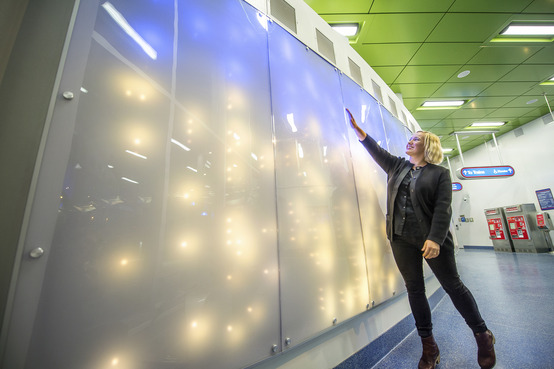
News . Feature Stories . Interactive mural by Jessica Langley '05 represents the energy of Cleveland
News
January 22, 2015
Interactive mural by Jessica Langley '05 represents the energy of Cleveland
Installation enlivens new RTA station on Cedar Hill

By Cindi Deutschman-Ruiz
New York artist Jessica Langley and Cleveland artist Andy Curlowe gave themselves a challenging assignment when they decided to propose a public art installation for Cleveland’s new Cedar Hill RTA station. “We wanted something that represented the energy of Cleveland and the community, without being too representational,” said Langley, a 2005 graduate.
After brainstorming, researching, and sketching, their final proposal won the approval of the RTA, and eventually the city planning commission, contractors, architects, and engineers.
By October, Langley’s and Curlowe’s finished piece was installed and winning approval from the Clevelanders whose energy they hoped to represent.
Emergence comprises 11 panels mounted to an inside wall and embedded with nearly 6,500 interactive LED lights. Blue lights across the top of the piece represent Lake Erie, and the entire Ohio shoreline is represented in the boundary between those blue lights and the white lights below.
There are “infrared sensors on each LED panel, and when a sensor is interrupted (by someone walking past) it makes the light turn on,” Langley explained. “There’s always a shimmer, but as individuals walk past the wall, their motion illuminates portions of the installation.” In a sense, human energy is both reflected and used by the piece.
“We were imagining that each LED light was a person… and any one individual can only illuminate one area of the piece,” she said. “You need a group to illuminate the whole shoreline. The idea is it takes a community to create the idea of a place.”
Both Langley and Curlowe are interested in landscape and how to represent it. “We’re interested in ideas of how you define place and what that means. It’s not just the actual contours of the shoreline; there are many things that define a place. A place is a reflection of the people that are in it.”
Prior to taking on this project, Langley had never done public art, and it was a learning experience to be part of something with so many different stakeholders. “I would definitely do it again, but it is a really different way of working.”
Launched in 1991, the RTA’s Arts in Transit Program established a policy of setting aside one percent of a project’s construction costs for public art. Since then, installations have been placed at rail stations, transit centers and the walkway to Gateway. Langley’s installation represents another mark that CIA artists have left on Cleveland.
With Emergence behind her (and documentation of it in hand as she considers possible future public art projects), Langley focused her energy on numerous other projects. By mid-autumn, she had shows up—in Pittsburgh, Brooklyn and Burlington, Vermont.
That she had three simultaneous shows is no surprise to her former professors, friends and followers. In the decade since she graduated from CIA, Langley earned an MFA from Virginia Commonwealth University, and won a Fulbright Scholarship and a Leifur Eriksson Scholarship that supported artist residencies in Reykjavik, Iceland. She has also been tapped to spend 2015 as a Digital Painting Atelier at Ontario College of Art and Design, in Toronto.
An ongoing project brought Langley to Cleveland in November. She and her husband, fellow 2005 graduate Ben Kinsley, participated in CIA’s academic conference, Unruly Engagements: On the Social Turn in Contemporary Art and Design. They gave a presentation to the CIA community and conference attendees from around the world about the “Janks Archive” that they have been compiling with partner Jerstin Crosby.
The term janks refers to a style of sly comebacks and insults common to the part of Alabama where Crosby grew up. The “Janks Archive” is an evolving web database and video installation featuring a collection of put-downs gathered from many cultures around the world.
In explaining the ideas behind the project, Kinsley cited the quote often attributed to Sigmund Freud, “The man who first flung a word of abuse at his enemy instead of a stone was the founder of civilization.” (janksarchive.org)
Cindi Deutschman-Ruiz is a freelance writer/editor and instructor of journalism and mass communication. She lives on the West Side of Cleveland.
Latest Headlines view all
-
April 02, 2024
Cleveland Institute of Art students partner with Progressive Art Collection to exhibit Ready, Set, Relay! -
March 04, 2024
Cleveland Institute of Art announces Curlee Raven Holton Inclusion Scholar Program -
November 06, 2023
Collision of art and artificial intelligence creates murky waters for artists, curators and educators
Questions?
For more information about this or other CIA news, contact us here.
Social Feed